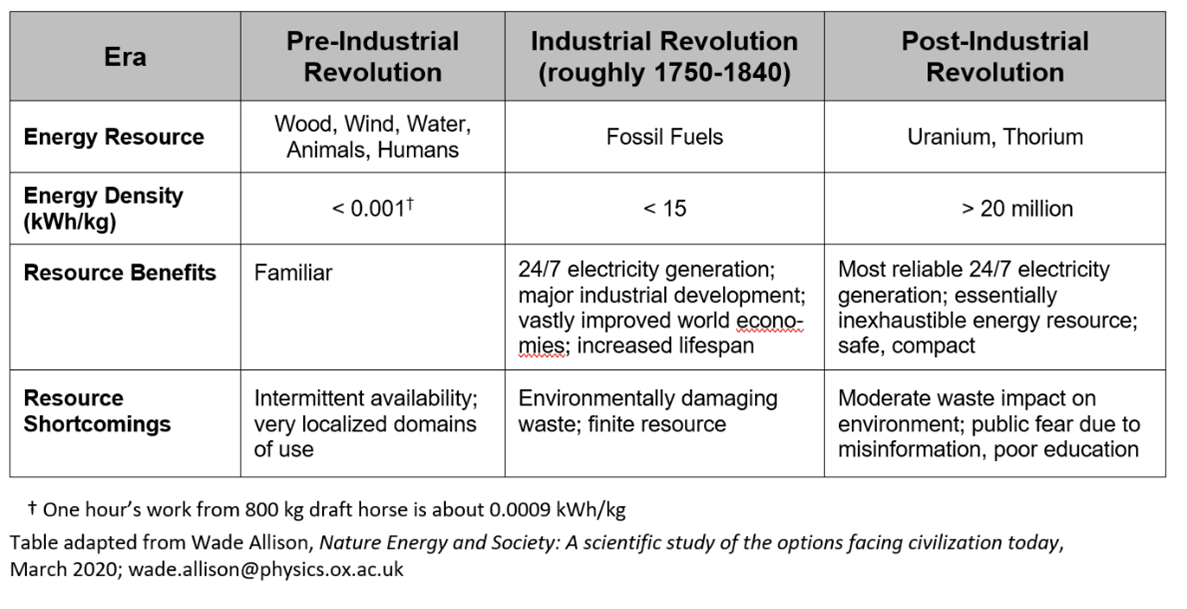
America’s energy policy is an unmitigated disaster, being driven by a catastrophic man-made climate-change hoax. Instead of using nuclear energy to generate abundant, affordable, and reliable electricity, our leaders are turning back to pre-industrial-revolution energy resources that will never be adequate to meet even our current electricity needs, much less the increased electrical demands of the future.
Let’s take an objective look at the alternatives for generating electricity to understand why reverting to sunbeam collectors and windmills will not only be inadequate to power America’s 21st century economy, but will also have a larger detrimental effect on the environment than embracing nuclear energy. There are four factors that should be considered when choosing energy resources for generating electricity:
- resource energy density,
- energy conversion system efficiency,
- electricity-generating system capacity factor, and
- resource utilization impact on the environment.
Why are these factors important? Because they determine 1) how much of an energy resource will actually be needed to meet the demands of residential and commercial consumers of electricity, 2) how many other resources will be needed to convert an energy resource to electricity, and 3) how the environment will be affected in meeting these needs. These considerations should be the primary drivers of decisions regarding how America should be generating electricity. The first of these factors will be addressed in this article. The remainder will be addressed in subsequent articles.
Energy Density
The most important single attribute of the various resources for generating electricity is energy density. The accessibility of energy resources of greater energy density has enabled the evolution of human civilization, as shown in the table below. In ancient times, humans used domesticated animals and slaves to do work, and the heat of wood fires to cook food and provide warmth. Mere survival was a daily chore. Later they used the power of water and wind to drive mills and the heat of fires to refine and fashion metals. Oils were used in lamps to illuminate the darkness. Nevertheless, lives were still very short. The energy density of these resources was very dilute, less than 0.001 kilowatt-hour per kilogram of resource material.

Technology developments in the industrial revolution period provided access to energy resources of greater energy density, providing humans with more abundant energy and allowing progress beyond a survival mode of existence. The harnessing of fossil fuels and the development of energy-conversion machines, such as the steam engine, resulted in economic expansion and increased human lifespans. Fossil fuels powered the industrial revolution and continue to provide the majority of our electricity needs. They made possible the machines that made life easier for our predecessors, and they enable the technology that dominates our lives today.
Without fossil fuels, the modern world would not have been possible; no hospitals, no modern medicine, no reliable summertime cooling or wintertime heating, no transportation beyond riding animals, etc. All this was possible because the energy density of fossil fuels, as shown in the table, is about 15,000 times greater than that of energy resources available prior to the industrial revolution.
The post-industrial revolution era, beginning at the end of World War II, saw the harnessing of the energy contained in the atomic nucleus of heavy elements such as uranium. The energy density of uranium is more than a million times greater than that of fossil fuels and more than 20 billion times greater than that of available resources prior to the industrial revolution. As a consequence, a relatively small amount of nuclear fuel can provide the electricity needs of very large populations.
Energy density is also key to minimizing environmental impact while meeting an ever-increasing demand for energy. The enormous energy density of nuclear fuel results in much less impact on the environment than fossil fuels for the same energy content. And despite the marketing rhetoric for solar and wind energy resources, the environmental impact of these resources is anything but benign. That issue will be addressed in a subsequent article.
Other articles in this series:
Back to Energy’s Future? — Part 2
Back to Energy’s Future? — Part 3
Back to Energy’s Future? — Part 4
Back to Energy’s Future? — Part 5
Back to Energy’s Future? — Part 6
Back to Energy’s Future? — Part 7




